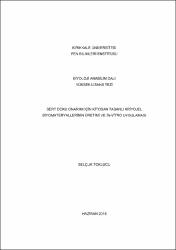| dc.contributor.advisor | Türk, Mustafa | |
| dc.contributor.author | Toklucu, Selçuk | |
| dc.date.accessioned | 2021-01-16T19:12:29Z | |
| dc.date.available | 2021-01-16T19:12:29Z | |
| dc.date.issued | 2015 | |
| dc.identifier.uri | | |
| dc.identifier.uri | https://hdl.handle.net/20.500.12587/16868 | |
| dc.description | YÖK Tez ID: 418492 | en_US |
| dc.description.abstract | Vücuttaki en sert dokulardan biri olan kemik, travma veya hastalık sonucunda meydana gelen hasarların iyileşmesi 3 ile 6 ay arasında zaman alan iyileşme süreci yavaş olan bir dokudur. Yalnızca ABD'de hastalık veya travma sonucu her yıl yaklaşık iki milyon kemik kırığı meydana gelmektedir. Bu tez çalışmasının amacı, çeşitli doku iskeleleri sentezleyerek onların sert doku grefti olarak kemik doku iyileşmesindeki potansiyel kullanılabilirliğinin araştırılması ve daha hızlı kemik iyileşmesi sağlamaktır. Bu amaçla, kitosan tabanlı 7 farklı doku iskelesi hazırlanmıştır. Kitosana ek olarak kollajen, hyaluronik asit, trombositçe zengin plazma (TZP) veya bunların kombinasyonları kullanılarak doku iskeleleri sentezlenmiştir. Yapılan taramalı elektron mikroskop analizleriyle (SEM) bu doku iskelelerinin hücresel çalışmalara uygun olduğu belirlenmiştir. Kemik doku rejenerasyonunda rol oynayan MC3T3-E1 pre-osteoblastik hücreleri, doku iskeleleri üzerine ekilerek farklı sürelerle inkübe edilmiştir (1, 3, 7 ve 10 günlük). Hücre içeren doku iskeleleri farklı inkübasyon sürelerinde alkalen fosfataz enzim aktivitesi, WST-1 testi kullanılarak hücre proliferasyonu ve sitotoksisitesi ve SEM analizleri yapılarak hücre adezyonları değerlendirilmiştir. Özellikle üçüncü günde, hyaluronik asit ve trombositçe zengin plazma karışımının, %127,63 hücre canlılık oranı, %123,25 alkalen fosfataz enzim aktiviteleri ile hücre proliferasyonuna ve hücre tutunmasına pozitif etkileri en yüksektir. Üçüncü gün ile kıyaslanırsa, yedinci günde tüm gruplarda hücre canlılığında azalma görülmesine rağmen hyaluronik asit ile desteklenmiş grupta en yüksek hücre canlılığı (%99,83) ve alkalen fosfataz aktivitesi gözlenmiştir (%137,33). Diğer yandan trombositçe zengin plazma destekli grupta en düşük hücre canlılığı (%82) ve alkalen fosfataz aktivitesine sahiptir (%113,65). Kültürün son gününde ise tüm gruplarda hücre canlılığı düşmüştür. Son deney günündeki en yüksek canlılık (%81,08) ve alkalen fosfataz aktivitesi (%97,71) kollajen-hyaluronik asit destekli gruptayken hyaluronik asit ile desteklenmiş grup ise en düşük canlılığına (%61,8) sahiptir. Özetlenecek olursa, trombositçe zengin plazmanın pozitif etkileri yedinci günde, hyaluronik asitin pozitif etkileri onuncu günde gözlemlenmemiştir. Trombositçe zengin plazma ve hyaluronik asitinin geliştirilmesi, kontrollü degredasyonu ve salınmasıyla pozitif etkilerinden daha uzun süreli faydalanılarak sert doku defektlerinin daha hızlı iyileşmesi sağlanabilir. | en_US |
| dc.description.abstract | Bone, which is one of the hardest tissue in the body, heals slowly following its injury due trauma or disease and it takes 3 or 6 months to heal. Just in US, about 2 million cases of trauma or disease-related bone fractures occur every year. The aim of the present study was to synthesize various scaffolds and to investigate their potential use as hard tissue grafts to facilitate a process of faster bone healing. For this purpose, chitosan based 7 different tissue scaffolds were prepared. In addition to chitosan, scaffolds were synthesized of either collagen, hyaluronic acid, platelet-rich plasma or their different combinations. Scanning electron microscopic (SEM) analysis indicated that scaffolds were convenient for cellular assays. The MC3T3-E1 pre-osteoblastic cells, which plays a role in bone tissue regeneration were seeded on scaffolds and incubated for different time periods (1, 3, 7 and 10 days). Scaffolds containing cells for different incubation periods were evaluated for alkaline phosphatase activity, cell proliferation and cytotoxicity by a WST-1 test, and cell adhesion by SEM analysis. Especially at the third day, the mixture of hyaluronic acid and platelet rich plasma exhibited the highest positive effect on cell attachment, cell proliferation with a 127.63% cell viability rate and on alkaline phophatase activity with a 123.25% activity. Although the cell viability rate decreased in all groups at the 7th day of culture compared to those of the 3rd day, the hyaluronic acid supported group had the highest rate of cell viability (99.83%) and alkaline phosphatase activity (137.33%). On the other hand, platelet-rich plasma supported group had the lowest cell viability (82%) and alkaline phosphatase activity (113.65%). At the last day of the culture, the cell viability rate declined in all study groups. Collagen-hyaluronic acid supported group had the best viability (81.08%) and alkaline phosphatase activity (97.71%) at the last day while hyaluronic acid supported group had the lowest cell viability (61.8%). In brief, we did not detect the positive effects of platelet-rich plasma's on cell proliferation at the 7th day and hyaluronic acid's at the 10th day and so on. Following enrichment and controlled degradation or delivery of platelet-rich plasma and hyaluronic acid, the positive effects can be utilized for a longer duration time to augment healing of hard tissue defects. | en_US |
| dc.language.iso | tur | en_US |
| dc.publisher | Kırıkkale Üniversitesi | en_US |
| dc.rights | info:eu-repo/semantics/openAccess | en_US |
| dc.subject | Biyoloji | en_US |
| dc.subject | Biology ; Biyomühendislik | en_US |
| dc.subject | Bioengineering | en_US |
| dc.subject | | en_US |
| dc.subject | | en_US |
| dc.subject | | en_US |
| dc.subject | | en_US |
| dc.subject | | en_US |
| dc.subject | | en_US |
| dc.title | Sert doku onarımı için kitosan tabanlı kriyojel biyomateryallerinin üretimi ve in-vitro uygulaması | en_US |
| dc.title.alternative | Production and in-vitro application of chitosan based cryogel biomaterials for hard tissue repair | en_US |
| dc.type | masterThesis | en_US |
| dc.contributor.department | KKÜ, Fen Bilimleri Enstitüsü, Biyoloji Anabilim Dalı | en_US |
| dc.identifier.startpage | 1 | en_US |
| dc.identifier.endpage | 79 | en_US |
| dc.relation.publicationcategory | Tez | en_US |
















